
EuroVelo is a network of 17 long-distance cycling routes criss-crossing Europe, in various stages of completion. When completed, the EuroVelo network's total length will be almost 90,000 km (56,000 mi). As of November 2022 more than 56,000 km (35,000 mi) were in place. EuroVelo is a project of the European Cyclists' Federation (ECF).

A rail trail is a shared-use path on railway right of way. Rail trails are typically constructed after a railway has been abandoned and the track has been removed but may also share the right of way with active railways, light rail, or streetcars, or with disused track. As shared-use paths, rail trails are primarily for non-motorized traffic including pedestrians, bicycles, horseback riders, skaters, and cross-country skiers, although snowmobiles and ATVs may be allowed. The characteristics of abandoned railways—gentle grades, well-engineered rights of way and structures, and passage through historical areas—lend themselves to rail trails and account for their popularity. Many rail trails are long-distance trails, while some shorter rail trails are known as greenways or linear parks.

Michael Cramer is a German politician who served as Member of the European Parliament (MEP) from 2004 until 2019. He is a member of the Alliance 90/The Greens, part of the European Green Party.

The German Green Belt is a project of Bund Naturschutz (BUND), one of Germany's largest environmental groups. The project began in 1989 facing the 870-mile (1,400 km) network of inner-German border fences and guard towers formerly separating East and West Germany. It is one of the world's most unusual nature reserves, lying along the old "Death Strip," turning a monument to repression into a symbol of renewal.

The European Green Belt initiative is a grassroots movement for nature conservation and sustainable development along the corridor of the former Iron Curtain. The term refers to an environmental initiative as well as the area it concerns. The initiative is carried out under the patronage of the International Union for Conservation of Nature and formerly Mikhail Gorbachev. It is the aim of the initiative to create the backbone of an ecological network that runs from the Barents to the Black and Adriatic Seas.

The Mühlviertler Schnellstraße (S10) is an expressway (Schnellstraße) in the Austrian state of Upper Austria, scheduled to run from the Mühlkreis Autobahn (A7) at Unterweitersdorf to the Austrian-Czech border at Wullowitz near Leopoldschlag. It is part of the European route E55.

EuroVelo 12 (EV12), the North Sea Cycle Route, is a 5,942 km (3,692 mi) long-distance cycling route circuit around the coastlines of the countries that border the North Sea: these countries are England, Scotland, Norway, Sweden, Denmark, Germany, the Netherlands and Belgium.
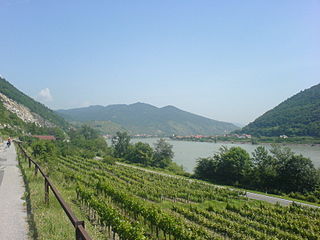
EuroVelo 6 (EV6), named the "Rivers Route", is a EuroVelo long-distance cycling route that runs along 3,653 km (2,270 mi) some of Europe's major rivers, including much of the Loire, some of the Saône, a short section of the upper Rhine and almost the entire length of Europe’s second longest river, the Danube — from the Atlantic coast of France to the city of Constanța on the Black Sea.

During the Cold War, the Iron Curtain is a political metaphor used to describe the political boundary dividing Europe into two separate areas from the end of World War II in 1945 until the end of the Cold War in 1991. The term symbolizes the efforts by the Soviet Union (USSR) to block itself and its Satellite States from open contact with the West, its allies and neutral states. On the east side of the Iron Curtain were the countries that were connected to or influenced by the Soviet Union, while on the west side were the countries that were NATO members, or connected to or influenced by the United States; or nominally neutral. Separate international economic and military alliances were developed on each side of the Iron Curtain. It later became a term for the 7,000-kilometre-long (4,300 mi) physical barrier of fences, walls, minefields, and watchtowers that divided the "east" and "west". The Berlin Wall was also part of this physical barrier.

The Danube is the second-longest river in Europe, after the Volga in Russia. It flows through Central and Southeastern Europe, from the Black Forest south into the Black Sea. A large and historically important river, it was once a frontier of the Roman Empire. In the 21st century, it connects ten European countries, running through their territories or marking a border. Originating in Germany, the Danube flows southeast for 2,850 km (1,770 mi), passing through or bordering Austria, Slovakia, Hungary, Croatia, Serbia, Romania, Bulgaria, Moldova, and Ukraine. Among the many cities on the river are four national capitals: Vienna, Bratislava, Budapest, and Belgrade. Its drainage basin amounts to 817,000 km² and extends into nine more countries.

A long-distance trail is a longer recreational trail mainly through rural areas used for hiking, backpacking, cycling, horse riding or cross-country skiing. They exist on all continents except Antarctica.
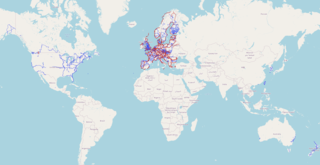
Long-distance cycling routes are designated cycling routes in various countries around the world for bicycle tourism. These routes include anything from longer rail trails, to national cycling route networks like the Dutch LF-routes, the French Veloroute or the routes of the British National Cycle Network, to the multi-state routes of the United States Bicycle Route System, to the multi-country routes of the EuroVelo network in Europe, the longest of which is over 6,800 km (4,200 mi) in length.

The German Cycling Network is the national cycling route network of Germany. There are currently 12 such long-distance cycling routes, called D-Routes criss-crossing the German nation and these were established mainly to promote bicycle tourism.
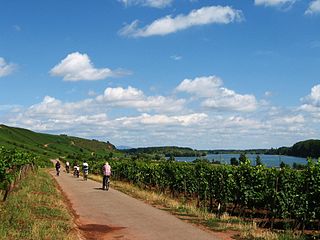
EuroVelo 15 (EV15), named the Rhine Cycle Route, is a EuroVelo long-distance cycling route running 1230km along the Rhine river valley from the headwaters of the Rhine in Andermatt in Switzerland to the river's mouth in Hook of Holland in the Netherlands. The route crosses Europe from south to north, from the Swiss Alps to the North Sea, passing through four countries: Switzerland, France, Germany and the Netherlands.

EuroVelo 7 (EV7), named the Sun Route, is a 7,409 km (4,604 mi) long EuroVelo long-distance cycling route running north–south through the whole of Europe from the North Cape in Norway to the island of Malta in the Mediterranean Sea. The route passes through nine countries, and from north to south these are: Norway, Finland, Sweden, Denmark, Germany, Czech Republic, Austria, Italy, Malta.

EuroVelo 2 (EV2), named The Capitals Route, is a 5,050 km (3,140 mi) long EuroVelo long-distance cycling route running from Galway, Ireland to Moscow, Russia. This east-west route passes successively through seven countries – Republic of Ireland, the United Kingdom, the Netherlands, Germany, Poland, Belarus and Russia – and visits all their capital cities.

EuroVelo 3 (EV3), named the Pilgrims Route, is a EuroVelo long-distance cycling route running 5,650 km (3,510 mi) running from Trondheim in Norway to Santiago de Compostela in Spain. This north-south route travels through Europe passing successively through seven countries: Norway, Sweden, Denmark, Germany, Belgium, France and Spain.
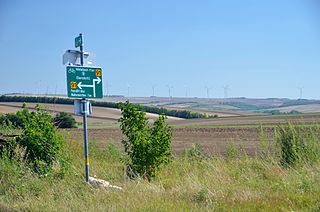
EuroVelo 9 (EV9), named the Amber Route - is a 1,930 km (1,200 mi) long EuroVelo long-distance cycling route running from the city of Gdańsk, Poland on the Baltic Sea to Pula, Croatia on the Adriatic Sea. It is called the Amber Route as historically the precious stone amber found in the Baltic region was taken by routes such as this to the Mediterranean Sea. This north-south cycle route runs through Central Europe and passes successively through six countries: Poland, Czech Republic, Austria, Slovenia, Italy, and Croatia.
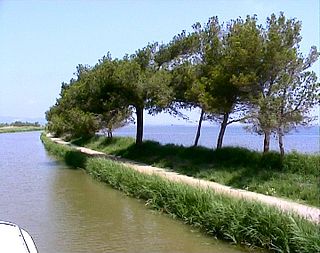
EuroVelo 8 (EV8), named the Mediterranean Route, is a 7,560 km (4,700 mi) long EuroVelo long-distance cycling route running from Cadiz, Spain to Athens, Greece, and then continuing to İzmir, Turkey and to the island of Cyprus. The route runs east-west across Europe mainly along or close to the Mediterranean coast, passing successively through 12 countries: Spain, France, Monaco, Italy, Slovenia, Croatia, Bosnia-Herzegovina, Montenegro, Albania, Greece, Turkey, and Cyprus.

EuroVelo 5 (EV5), named the Via Romea Francigena, is a 3,900 km (2,400 mi) long EuroVelo long-distance cycling route running from Canterbury to Rome and ending at the Italian port of Brindisi. The route crosses Europe passing successively through six countries: UK, France, Belgium, Luxembourg, France again, Switzerland and Italy.




















